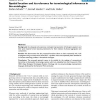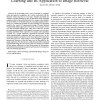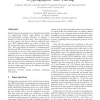917 search results - page 92 / 184 » Comparison of Data Structures for Computing Formal Concepts |
BMCBI
2007
14 years 10 months ago
2007
Background: An adequate and expressive ontological representation of biological organisms and their parts requires formal reasoning mechanisms for their relations of physical aggr...
110
click to vote
TIP
2010
14 years 8 months ago
2010
—In increasingly many cases of interest in computer vision and pattern recognition, one is often confronted with the situation where data size is very large. Usually, the labels ...
IJNSEC
2008
14 years 9 months ago
2008
Identity-based cryptography uses pairing functions,which are sophisticated bilinear maps defined on elliptic curves.Computing pairings efficiently in software is presently a relev...
87
Voted
SIGMOD
2002
ACM
15 years 10 months ago
2002
ACM
Dwarf is a highly compressed structure for computing, storing, and querying data cubes. Dwarf identifies prefix and suffix structural redundancies and factors them out by coalesci...
SAC
2005
ACM
15 years 3 months ago
2005
ACM
Many geographical applications deal with spatial objects that cannot be adequately described by determinate, crisp concepts because of their intrinsically indeterminate and vague ...



